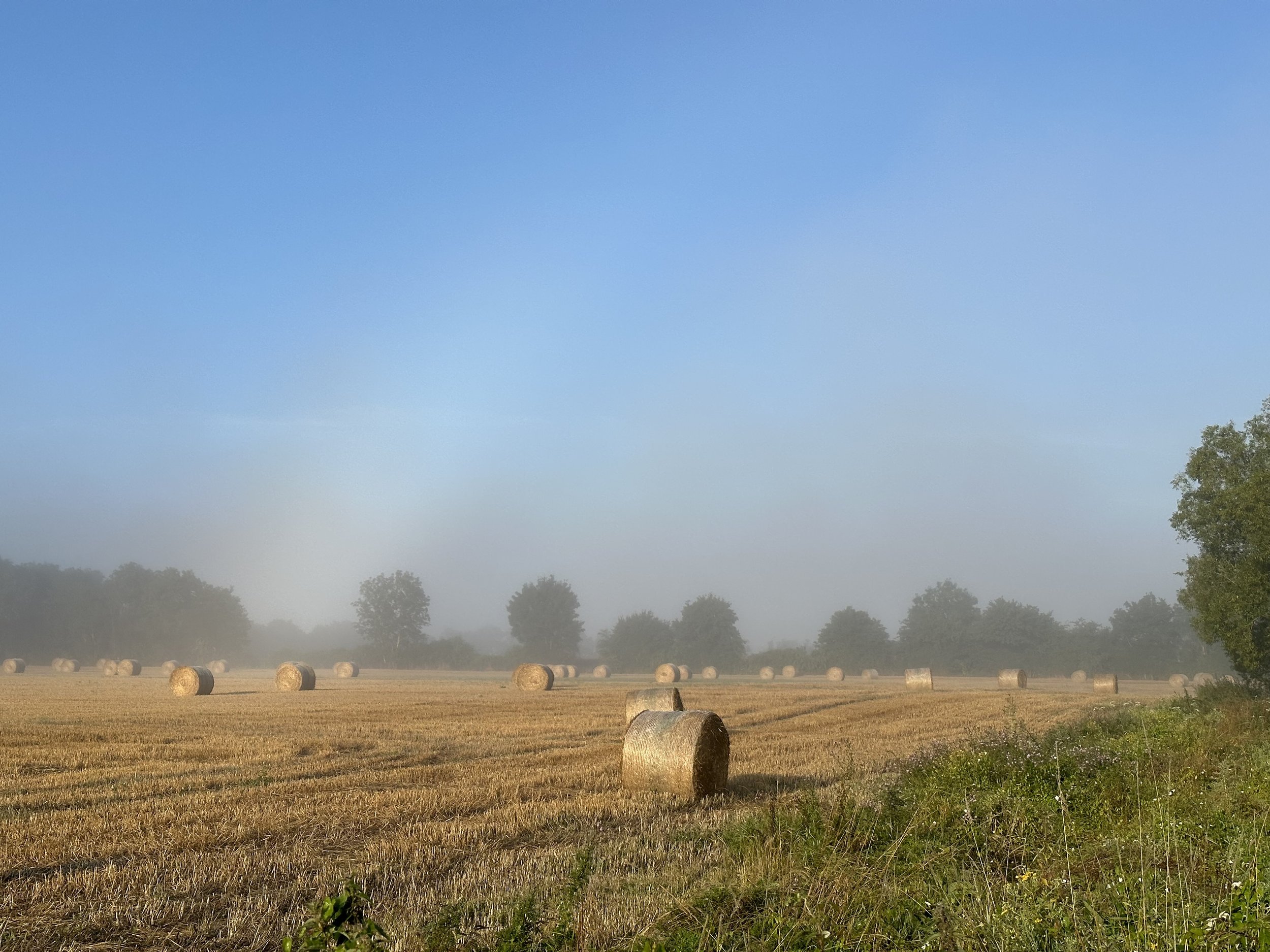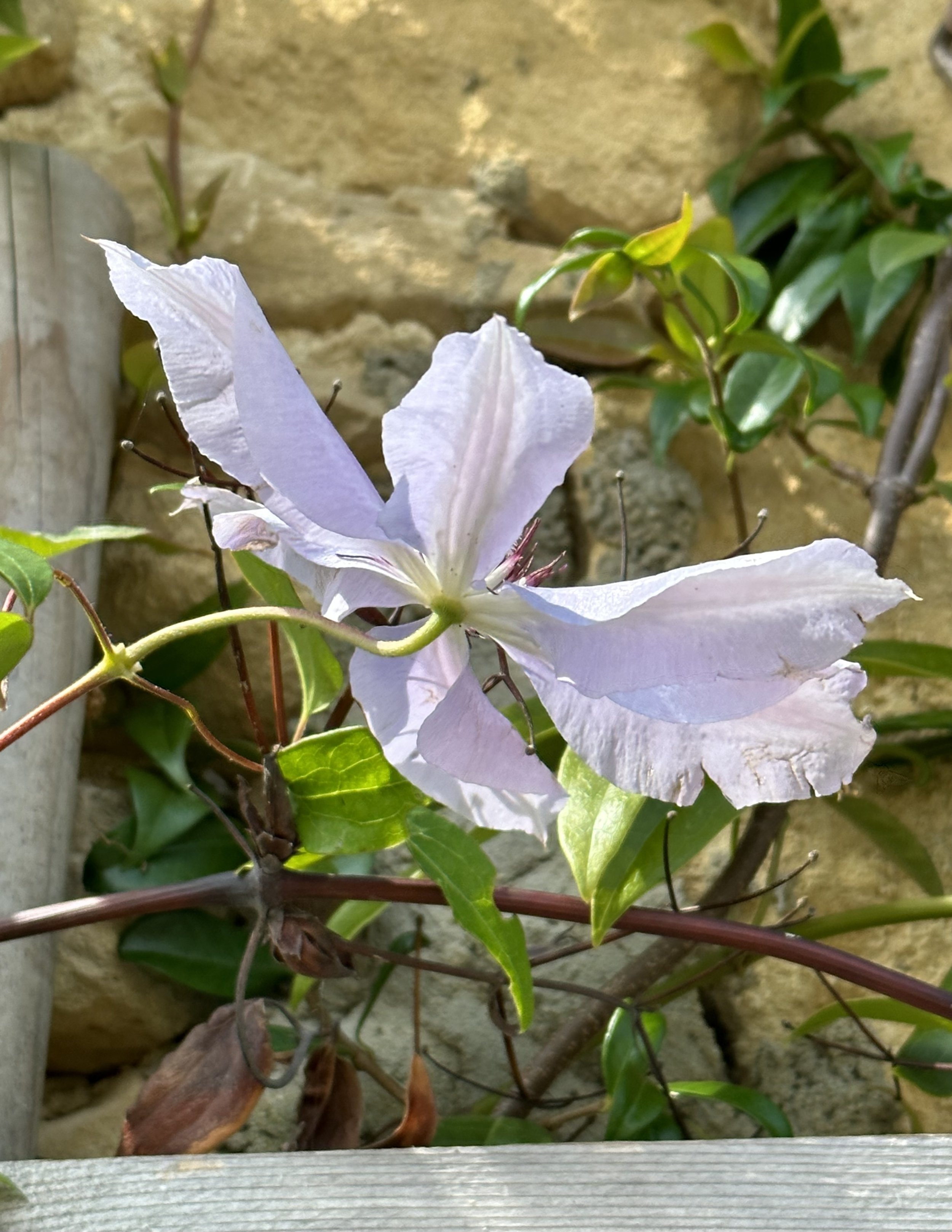"Ripeness is all"... midsummer at the chateau
A walk down the lane to Vieux Courtomer on a misty morning in midsummer...
Above: Round bales in our field, waiting to be loaded onto the wagons and hauled to the Basse Cour
Monday, July 31, 2023
Dear Valued Customer,
The air was full of mist this morning, cloaking the park in billowy dampness, blurring the outlines of trees and the edge of the woodland.
It’s the middle of summer in our corner of Normandy. La moisson, the grain harvest, is just behind us, thankfully finished in the heat and full sun of early July. Until last week, bales of straw lay like giant spools of golden thread upon the stubble of the fields. Now, we load them onto wagons. Almost waddling under their charge, the wagons haul the bales to sheds in the Basse Cour, the farmyard.
It’s been a good year for our wheat, oats and barley. Madame Brigitte, our farmer’s wife and his steadfast partner, gives me the tally and her opinion. The rendement is correct. Protein content, correcte. Les prix...so far, so good, she says, tempering our enthusiasm. Like every farmer, we try to gauge the best time to sell. We watch the conflict in the East with mingled apprehension and cold calculation. But even if scarcity comes with war, so too do high prices for les phytos – fertilizers and other agricultural chemicals – invested in the harvest. Meanwhile, we hear cereal prices will be lower this year.
Hazy morning, our field of wheat stubble gleams in the sun
But these days, there’s no time to read the news, even in the “L’Agriculteur Normand.” More immediately, we watch the skies. We’ve started cutting rapeseed, known here as colza. It’s one of our most valuable crops, and we count on it to make up for deficiencies or falling prices for other crops. But “une giboulée” – a sudden burst of rain – brought the harvester to a halt yesterday afternoon.
“La moisson stoppée par la pluie,” cries the headline from “L’Agriculteur,” describing the situation throughout Normandy.
Il faut faire avec. It is what it is, says Madame Brigitte, hurrying off to check on the cattle, with her quick, upright stride.
Early this morning, I took a walk to Le Vieux Courtomer, just down the road from the Chateau. I passed theTemple, luminous in the light fog, and turned down the lane past the truncated remains of the 12th-century church of Saint Etienne, surrounded by the village cemetery. A calvaire, coppery green with age, overlooks the juncture of the lane and the road here, looking away from the graveyard and out to the west. It was given to the village by the comte de Pelet, chatelain of Courtomer before us. It used to stand at the bus stop and crossroads up in the bourg. The last mayor thought Vieux Courtomer was a more fitting location. And we are glad to have it here, surveying this quiet corner with outstretched arms and an expression of tender sorrow.
Le Vieux Courtomer is the “site primitif” of Courtomer. It was once the main settlement around the original 12th-century Chateau and church. The scattered buildings, of stone and brick, include the former schoolhouse, the fine old rectory hidden behind overgrown shrubbery and trees, and a small farm once part of the Courtomer estate.
Daniel, sturdy and straight as a short tree trunk, stood in the misty air contemplating his squash plants and tomatoes. The courgettes, their lush, green leaves dusted with prickly down, grow like a crown around a group of tall tomato plants.
Daniel looked up.
“Do you know how old I am?” he asked. We’ve known him a long time. Not wanting to sound coy, I said nothing.
“I’ll be 90 on August 4.”
We both looked silently at the vigorous plants. A few of the tomatoes were beginning to redden, skin stretched taut and shiny over plump flesh. Ripeness is all...the tomatoes, at least, wouldn’t be ready for at least a week.
Daniel retired to Le Vieux Courtomer from farming in the Calvados decades ago. He bought the farmhouse with its cluster of small stone barns, its courtyard and well, and a patch of garden. Across the lane, he grows neat rows of cabbage and cucumbers, onions and beans. He’s just set out three rows of young lettuce plants from his cold frame. A crop of potatoes is coming along, to be harvested for consumption all winter long.
When we first came to Courtomer, Daniel used to cut wood in our park and along the edges of our pastures. We shared the logs, half for him, half for us.
“Dîtes le bonjour à Monsieur,” said Daniel.
“Je n’y manquerai pas, Daniel,” I replied. We nodded good-bye.
Clinging to the decorative metal flourishes of the metal gate, white spider webs were strung tightly from one twirling wire to the next. They glistened with fine dew.
Daniel's garden, admired on a walk to Le Vieux Courtomer
I went further down the lane. It dead ends in front of a small field and a shed loaded to the rafters with new round bales. This bout de terre is a vestige of farmland that belonged to the Chateau in the count’s time. Informally, I rent it to a neighbor. Once a year, he arrives on the perron of the Chateau, wearing tall rubber boots and a dark green combinaison. He is accompanied by his son. The child was four when we started our arrangement, and no longer needs to be admonished to remove his cap and stand up straight in the presence of la propriétaire. This year, the young man himself handed over the envelope. Thus does one generation succeed another in its obligations and bonne entente – its pleasant understanding and complicité.
The summer sun had begun to burn off the lingering dampness. I walked back up to the Chateau for un tour of the park, to see how our own plantations were coming along.
The garden beds are flourishing. Over the past two years, Monsieur Martyn has dressed the soil with rotted manure from the stables and mulch from our tree and lawn clippings. Among the new plants he brought in, the daylilies have had their glorious moment. Now the flowering stems have ripened into dry stalks. Other blooms have taken their place.
Years ago, our old gardien planted roses for me against the Farmhouse and the Orangerie walls. They are entering maturity now, heavy with repeat blooms, intensely fragrant as the sun releases scent from golden stamens. A couple of years ago, Monsieur Martyn continued the project with clematis and more roses against the walls of the Basse Cour. A clematis flower, dainty as a butterfly perches on its stem, twining up a trellis at the Farmhouse.
One of the new clematis blooms against the Farmhouse trellis and stone wall
Of the garden from the comte’s time, little but fragments remain. He, or more likely his mother, espaliered pear trees in the walled garden of the Orangerie and in the courtyard of the stables. These are still producing clusters of juicy pears, just beginning to ripen now.
There was also a line of apple trees painstakingly trained au cordon at the bottom of the walled garden. They got in the way of mowing; I came back one weekend to find that the gardien, in a fit of tidying up, had torn them out.
So, a few years ago, the gardien and our then-gardener, Michel, helped me plant a new orchard.
Set in the middle of the Basse Cour, the verger bears but scanty fruit. The apple trees are still only about a third of their mature size. The few apples are small and green, a promise of autumn harvests to come...in future years.
I planted this little orchard not just to replace what had been lost at Courtomer but, as I half-realized, a reminder of my childhood home.
Our grandfather had converted the family place in New York State from sheep to apple orchards in the 1920s. My father and his brother grew up counting bushels and minding the men who worked on the farm; all of their children, including myself, grew up knowing the crisp days of autumn harvest, the exotic arrival of the migrant pickers, the laughter of men and women in the barn as the red apples ran over conveyor belts to be sorted and packed into crates. We thrilled with eager anticipation as the foreman, Adam, polishing his thin metal-framed spectacles for the occasion, chose samples to enter in the county fair. We were taught to fear late frost. We had a horror of hail. We read the gradients on the rain gauge. We knew apple blights by abbreviated names, as if they were old and tiresome friends. And we scorned the bland flesh of store-bought apples. We took for granted the taste of fruit fresh plucked off the tree.
But it serves old memories ill to be overly faithful.
These apples are Normandy-bred. Unlike the varieties we grew, these are made for cider. And the days when the barnyard filled with many laughing voices are gone; farming today relies on machinery, not mains d’oeuvre.
Time, storms, and paroxysms of tempérament do their damage. And yet...there is continuity, if not a perfect circle. Michel had first come to Courtomer as a 14-year-old gardener’s boy. He learned pruning while tending to the ill-fated pommiers au cordon. After the count’s death and a long absence, he returned to the Chateau to work for us. Probably the pear trees I asked him to prune were already as gnarled then as his hands are now. Michel is long retired, having gracefully yielded to time’s inexorable passage.
And there is continuity of place and bonne entente. After all, the agent who sold me the apple trees at the local agricultural cooperative happens to live across the road from Le Vieux Courtomer. Rather than trust the trees to a shipper, he carried them to the Chateau in his own truck. He’s related to Madame Brigitte, too.
And so it goes.
A bientôt, au Chateau!
Elisabeth
One of the young apple trees in the orchard of the Basse Cour. In the background, the "porcherie" with simple new doors made by Monsieur Arnaud and painted by Monsieur Martyn.
P.S. If you would like to forward this email to a friend, please click here.
P.P.S. We are taking bookings for 2024 and 2025.
Heather (info@chateaudecourtomer.com and +33 (0) 6 49 12 87 98) will be delighted to help you with dates. And Jane will be happy to preview the property on site. She can also act as your concierge.
English and French spoken.
We look forward to hearing from you!





